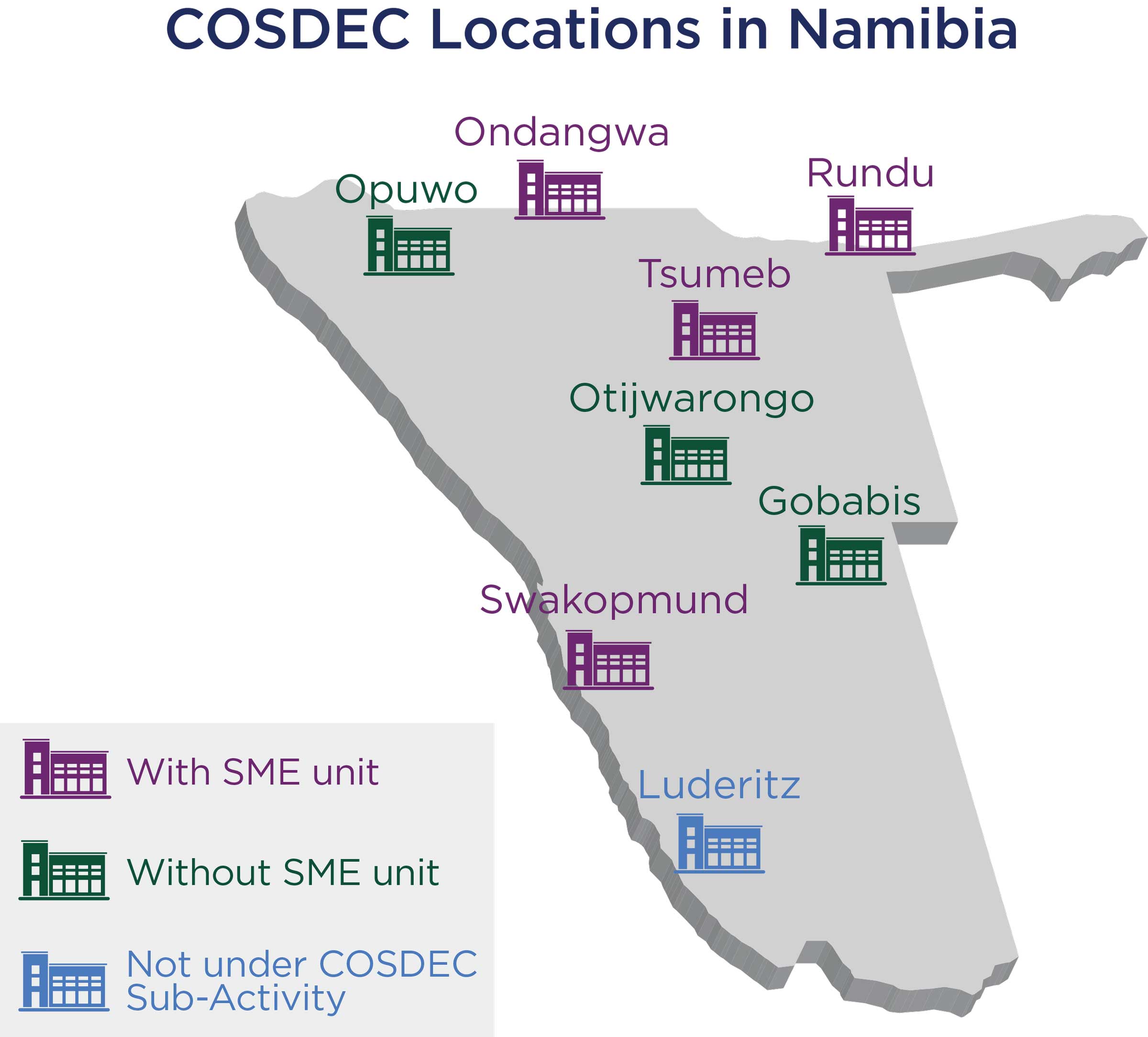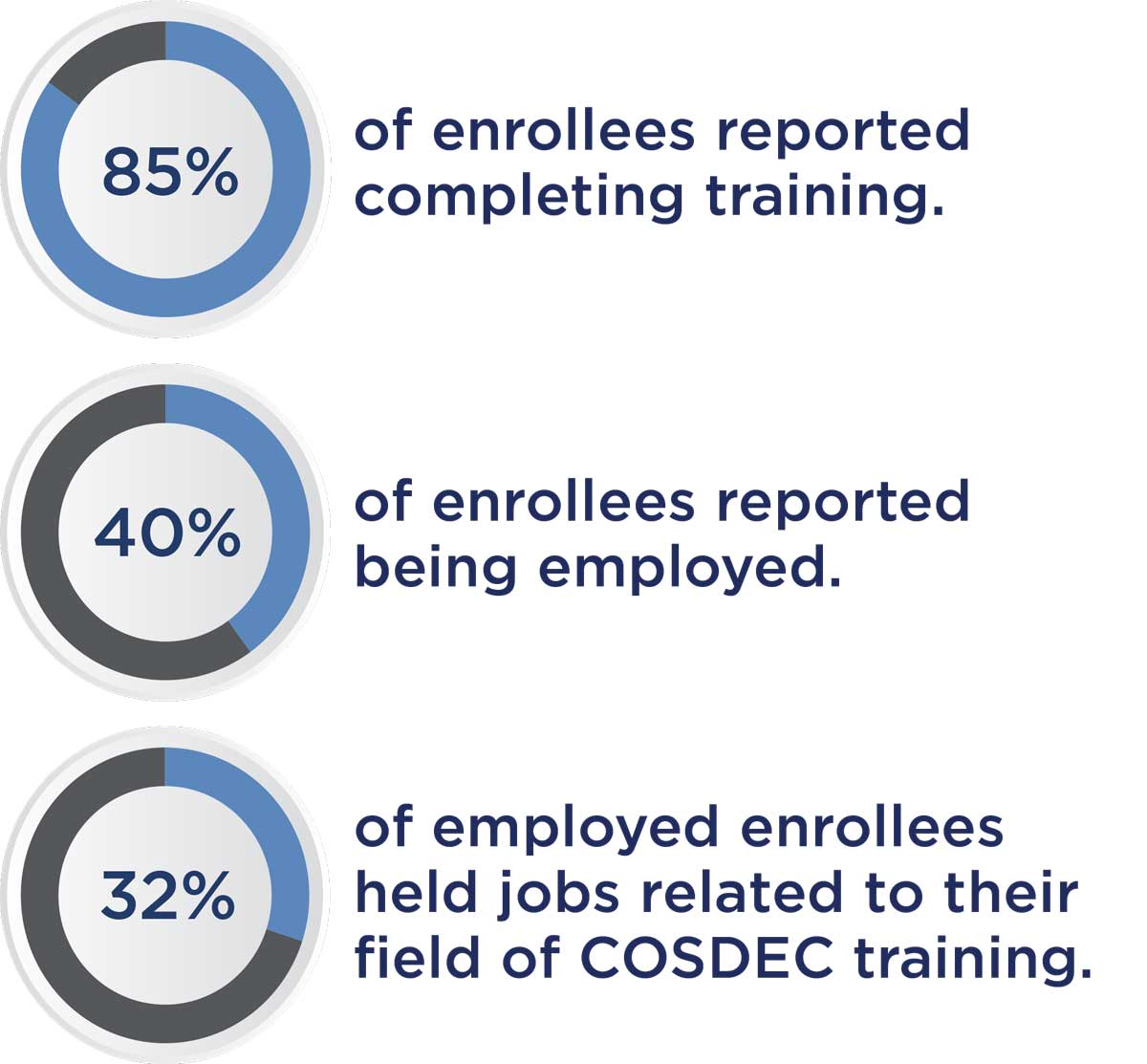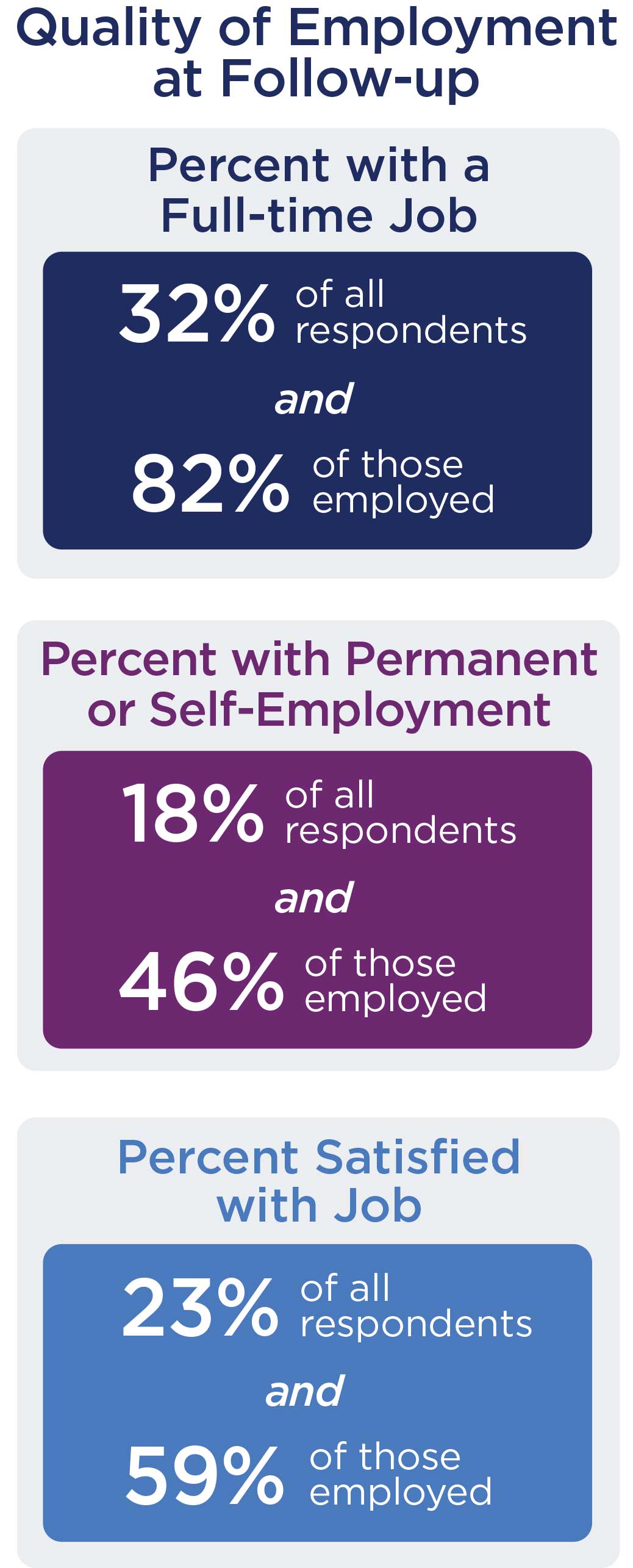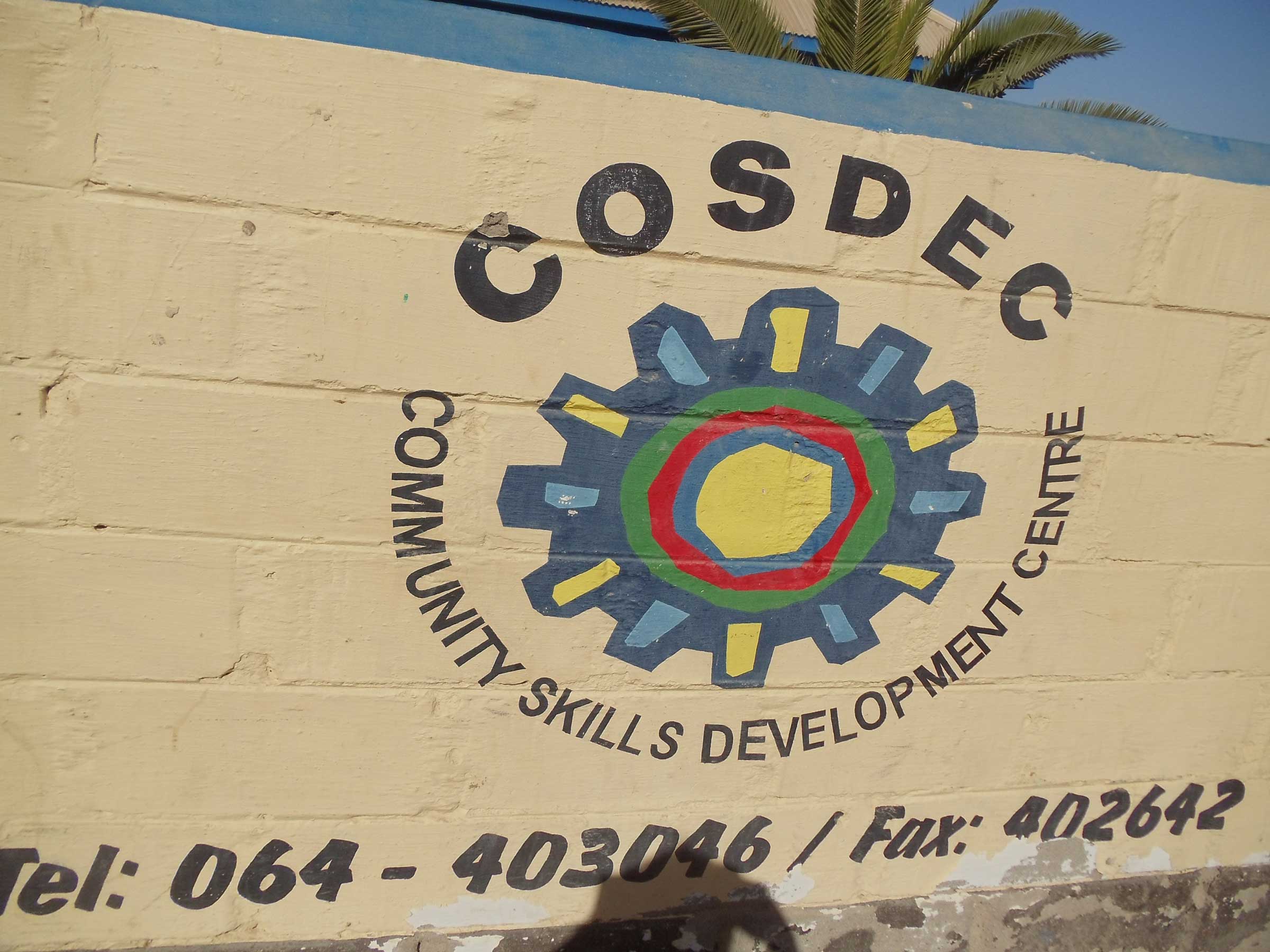Program Overview
MCC’s $295.7 million Namibia Compact (2009-2014) funded the $145 million Education Project, which included the $16.8 million Community Skills Development Center (COSDEC) Sub-Activity. The COSDEC Sub-Activity was designed to provide infrastructure support to vocational institutions and technical support to training staff and administrators, resulting in improved management practices and quality of training, increased access to training and enrollment, and increased employment and earnings for enrollees.
Evaluator Description
MCC commissioned Mathematica Policy Research to conduct an independent ex-post performance evaluation of the COSDEC Sub-Activity. Full report results and learning: https://data.mcc.gov/evaluations/index.php/catalog/199.
Key Findings
Improved COSDEC Infrastructure and Management
- Improvements to COSDEC infrastructure resulted in a more conducive learning environment and improved community perceptions.
- Most COSDECs expanded course offerings and increased the number of accepted trainees.
- COSDECs reported more inclusive and collaborative management and competence in developing annual budget plans.
- At the time of data collection, no supported COSDECs had received registration or accreditation through the Namibian government.
Training Completion
- As the reputations of COSDECs have improved, trainee applications have increased.
- One year after training ended, 85 percent of enrollees reported that they had completed their COSDEC courses and had positive views of the training.
- Only 6 percent of respondents in the evaluation sample enrolled into additional vocational training.
Employment and Income
- One year after the end of COSDEC training, approximately 40 percent of trainees reported being employed and 42 percent reported being productively engaged.
- Only 13 percent of employed enrollees held jobs related to their field of COSDEC training.
- While female enrollees had similar completion rates, they reported significantly lower employment rates and earnings than male enrollees.
Evaluation Questions
This performance evaluation was designed to answer six evaluation questions, a subset of which are listed below:
- 1
To what extent did the COSDEC Sub-Activity increase the availability of training? - 2
How did COSDEC training affect the employment and earnings outcomes of trainees? - 3
How were the new and renovated COSDECs managed? - 4
Did the employment and earnings outcomes of COSDEC trainees vary by trainee characteristics?
Detailed Findings
Improved COSDEC Infrastructure and Management

COSDEC construction and renovation targets were 100 percent accomplished. Stakeholders reported that the new COSDEC infrastructure provided a more conducive learning environment and improved perceptions of COSDECs in the community, which served to complement the management changes that took place in the COSDECs.
Following the renovations, most COSDEC institutions were able to expand on the number of offered courses at their institutions and increase the number of accepted trainees. COSDEC managers reported that their SME units were 80 to 100 percent full, although they reported frequently waiving fees due to the trainees’ inability to pay.
One year after the compact ended, it was reported that COSDEC staff and managers could competently develop their annual budget plans, take an active and collaborative role in strategic planning, and introduce more inclusive management styles to operations. COSDEC staff and management continued to develop their instructors post-compact through off-site training aimed at further improving instructors’ pedagogical skills and the quality of instruction.
However, despite positive changes in key management dimensions, the technical assistance provided under the compact had not yet resulted in meaningful changes in how COSDECs were marketed in the local communities. By the end of December 2016, none of the supported COSDECs was yet accredited or registered through the Namibian government, though most were at advanced stages in this process.

Training Completion
About 85 percent of enrollees surveyed one year after training ended reported that they had completed their COSDEC courses. Trainees’ perceptions of the training were generally very positive. As the COSDECs’ reputation in the community appeared to improve, trainee applications increased and several COSDECs had to turn away applicants.
However, only about 6 percent of respondents had enrolled in additional training since the start of their COSDEC course, even though most expressed an interest in doing so. This could be because COSDEC graduates could not enroll in subsequent levels of vocational education and training with other training providers without having to repeat levels they have already completed—due to the incomplete registration and accreditation processes of the COSDECs. COSDEC graduates’ plans for directly enrolling in further training may not be possible until this is resolved.

Employment and Income
One year after the end of COSDEC training, approximately 40 percent of trainees reported being employed and 42 percent reported being productively engaged (defined as holding a paid job or being engaged in further vocational training).
Among the trainees who were employed, about 32 percent held jobs related to their field of COSDEC training. In addition, many of those who were employed held jobs that were temporary and/or with which they were dissatisfied. These findings suggest that considerable challenges remain not only in improving the employability of COSDEC graduates, but also in improving their prospects of finding high quality employment. Approximately two-thirds of trainees did not report any earnings from self-employment or wages in the month prior to the survey. However, there is suggestive evidence across the Namibia Education Project findings that these employment challenges may be applicable more broadly to vocational training enrollees in Namibia, rather than being specific to COSDEC enrollees.
While female enrollees had similar training completion rates, they had significantly lower employment rates and earnings than male enrollees. Mean earnings were almost three times higher for males (N$2,316) than for females (N$810), a statistically significant difference. These gender differences are even larger in magnitude after controlling for differences in COSDEC and course, and cannot therefore be explained by differences in the types of courses males and females take.
MCC Learning
Vocational training interventions need a credible approach for identifying skills gaps in the labor market. Assessing market demand at a project level might include diagnostics of labor market trends, specific hiring challenges of key industries, and assessments of the feasibility and cost-effectiveness of supporting target populations to achieve the skills necessary to be hired.
Gender considerations may need to extend beyond immediate participation opportunities. Although women had similar training completion rates, they appear to face substantial challenges in the labor market relative to men. Where such labor market barriers are thought to exist, special attention could be given to enhancing the employment prospects of female trainees, such as linking them with female mentors in the community or undertaking affirmative action initiatives to provide direct and stronger support to female graduates.
Facilitating system-level behavior change in an organization requires more than simply “training.” In future investments, MCC should thoroughly assess the organization/institution as well as the key behaviors that must change in order to achieve project impact as a precursor to project design.
Evaluation Methods


A newly constructed COSDEC with an SME unit provided a workspace, subsidized materials, and support to entrepreneurs.
The COSDEC evaluation was an ex-post, mixed-methods performance evaluation. The qualitative analysis explored the implementation of the COSDEC Sub-Activity; how the COSDECs continued to evolve after compact implementation; and the prospects for sustainability. The quantitative analysis explored information about enrollees’ training and labor market outcomes about one-year after the end of COSDEC training.
The qualitative analysis was conducted over two rounds of data collection. The first round of data collection occurred between October and November 2014, and the second round of data collection between October and December 2015. The exposure period for the qualitative analysis was 4 to 18 months. The qualitative analysis drew on interviews and focus groups with COSDEC trainees, as well as interviews with MCA-Namibia staff, MCC resident country mission staff, implementers, the foundation that oversees the COSDECs, COSDEC managers, Namibia Training Authority staff, employers, Namibia Chamber of Commerce and Industry staff, and others.
The quantitative analysis follow-up survey was conducted between January and June 2016, approximately one year after the end of enrollees’ COSDEC training, and included all individuals who enrolled in targeted COSDEC courses between July and December 2014. The exposure period for the quantitative analysis was 12 to 16 months.
The follow-up survey consisted of 642 enrollees who were enrolled in 36 COSDEC courses across seven COSDEC institutions. The survey collected data on enrollees’ demographic characteristics, as well as their vocational training history, employment status, earnings and income.


